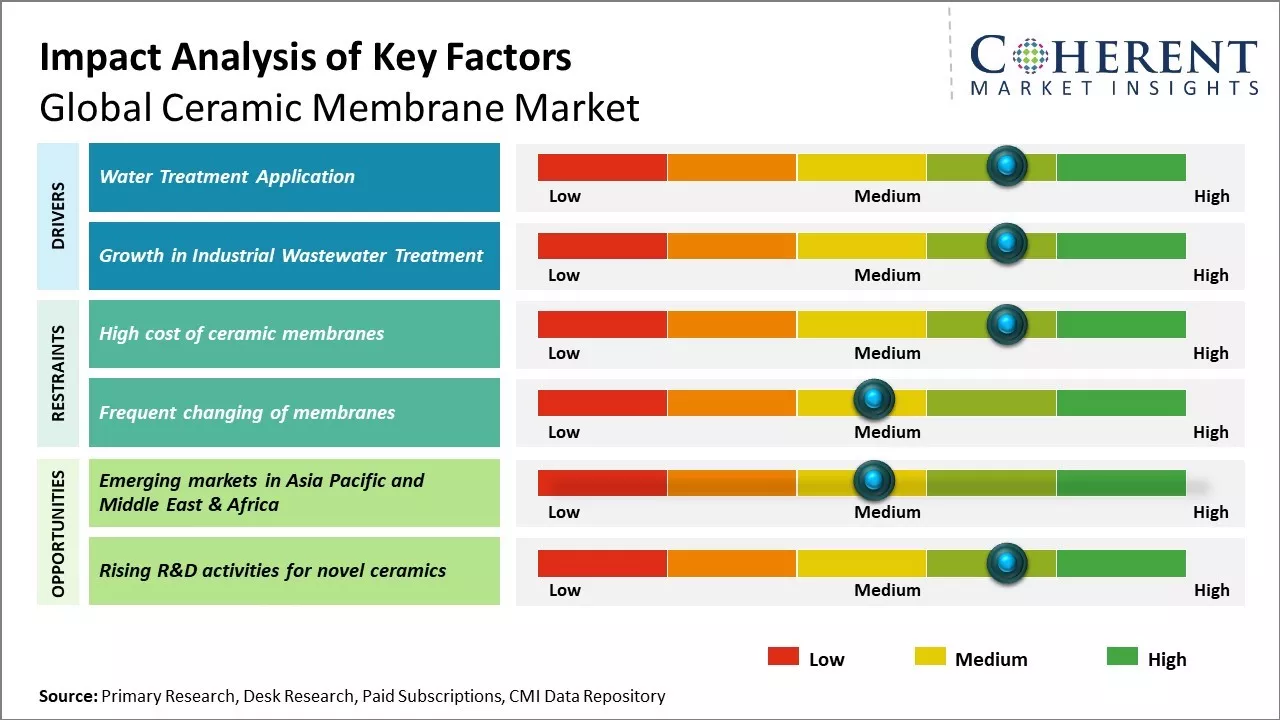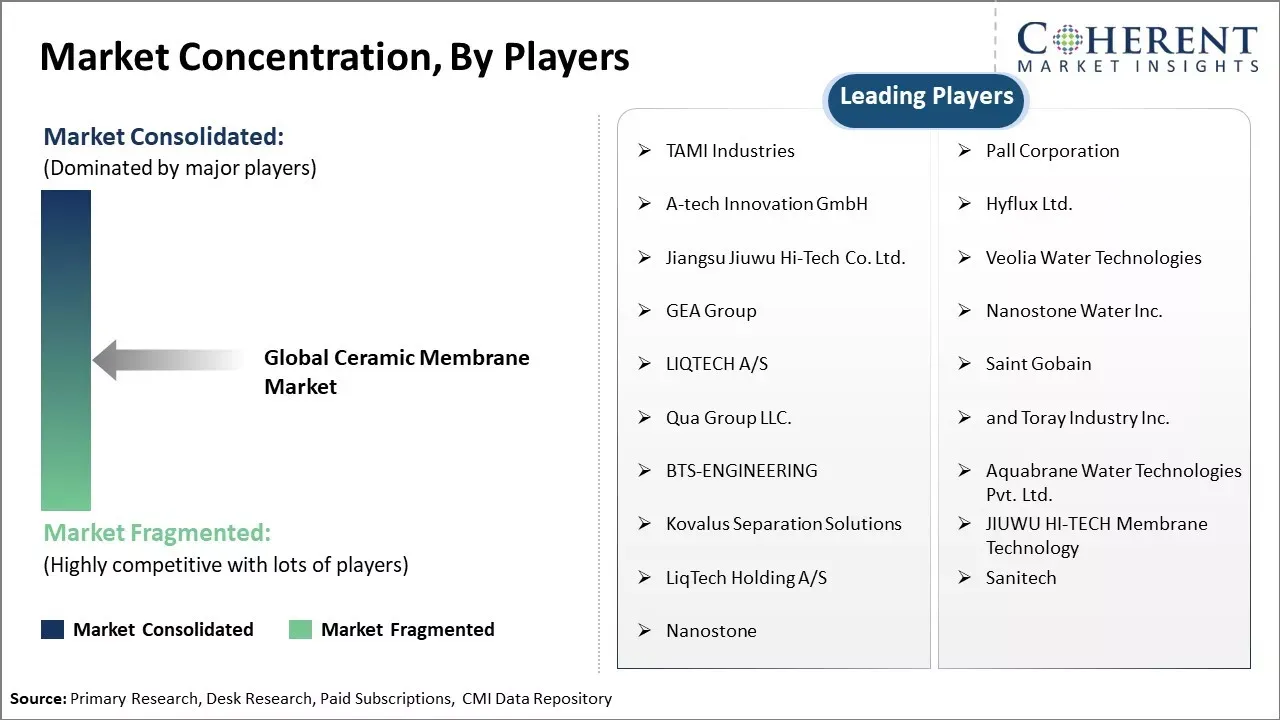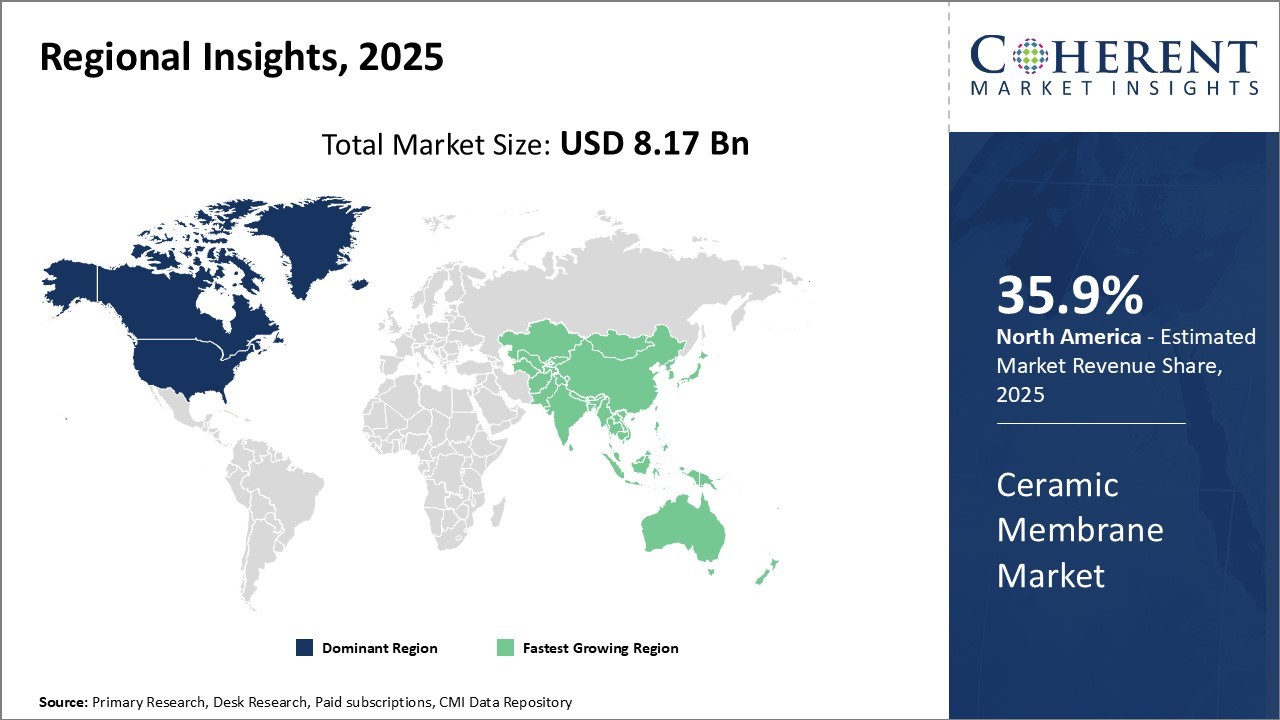The ceramic membrane market is estimated to be valued at USD 8.17 Bn in 2025 and is expected to reach USD 15.43 Bn by 2032, exhibiting a compound annual growth rate (CAGR) of 9.5% from 2025 to 2032.

To learn more about this report, Download Free Sample
The global ceramic membrane market is expected to witness significant growth over the forecast period. The increasing demand from water and wastewater treatment industries is estimated to boost the market growth. Ceramic membranes exhibit properties like mechanical strength, thermal, and chemical stability which makes them suitable for industrial filtration applications involving high temperature, pressure, and chemical processing. Their higher filtration properties render them a very suitable option for microfiltration and ultrafiltration operations in industries like food and beverage processing, pharmaceutical, biotechnology, and others. Additionally, strict environmental laws governing discharge of industrial wastewater are pushing industries toward investing in new water treatment technologies like ceramic membranes.
|
Current Events |
Description and its impact |
|
Nanostone Water Joins Major Asian Semiconductor Company |
|
|
Veolia Introduces New Ceramic Membrane System for Industrial Water Reuse |
|
Uncover macros and micros vetted on 75+ parameters: Get instant access to report
The prices of ceramic membranes are a function of raw material costs (primarily alumina, zirconia, and titania), sophistication of production, membrane type (tubular, flat sheet, monolithic), and end-use sector (e.g., water treatment, food & beverage, biotech). Typical ceramic membrane prices ranging from $300 to $2,000 per square meter, depending on porosity, structure, and chemical resistance, as of mid-2025.
Microfiltration ceramic membranes are relatively on the lower prices in the market, priced at $300–$800/m², but ultrafiltration and nanofiltration membranes that require even tighter pore sizes and specific coatings can be priced at $1,000–$2,000/m².
Prices have reduced over the last few years progressively due to economies of scale and rising production capacities, particularly in China, where domestic producers are competitive in terms of pricing. Still, the substantial capital investment in ceramic membrane systems, such as housings and modules, renders them more costly initially compared to polymeric ones—albeit with a lower cost of ownership overall because they have longer lifespans (10–15 years), greater durability, and lower maintenance.
Industrial wastewater treatment and high-temperature filter use justifies the premium price point due to demanding conditions of operation. Added application growth in pharmaceuticals and bioprocessing also promises to sustain premium price levels. Worldwide inflationary forces and freight costs briefly inflated prices between 2022–2023, though normalization of raw materials availability has reduced cost fluctuations between 2024–2025.
Although ceramic membranes are more expensive to implement initially, their improved longevity, longer shelf life, and improved performance are a rationale for their growth in applications within high-value markets.
Artificial Intelligence (AI) is making a transformative contribution to the ceramic membrane market by optimizing system efficiency, designing for optimality, and facilitating predictive maintenance. The most significant advantage of AI technology could be processing optimization. With the study of actual operating data from filtration systems, AI algorithms are able to change parameters such as flow rates, pressure, and backwash cycles to optimize filter efficiency and the life of the membranes.
In product development, AI simulations are accelerating the design of ceramic membranes of the future. Machine learning algorithms can forecast membrane performance from surface chemistry, pore morphology, and material composition with a significant saving in cost and time during R&D.
Predictive maintenance is also assisted by AI, as it monitors operational data (e.g., pressure drop, flux decline, fouling trends) to predict failure or degradation of membranes. It enables immediate cleaning or replacement, reducing downtime and increasing membrane life.
In large water and sewage treatment plants, artificial intelligence-based monitoring systems help the operators detect anomalies, optimizing energy consumption, and staying in compliance with regulations. For example, AI-based models can detect contaminants and suggest dynamic changes of filtration sequences or chemical dosing.
Moreover, AI is used in market analysis and demand forecasting as well, to help manufacturers optimize their production based on industry trends, regulatory changes, and regional water shortage. In short, AI reduces operating costs, makes ceramic membrane technologies more reliable, and inspires innovation to make them more and more attractive to high-performance filtration industries such as pharmaceuticals, food & beverage, and municipal water treatment. As they are used more widely, AI integration will be standard in next-generation membrane systems.
The stringent regulations related to wastewater treatment have compelled industries and municipalities to incorporate advanced water treatment solutions. Ceramic membranes have emerged as a reliable technology for filtration processes across various end-use sectors such as water & wastewater treatment, pharmaceuticals. Their advanced filtration capabilities allow the removal of even minute contaminants from water, enabling production of clean water conforming to stringent quality standards.
Various industries such as pharmaceuticals, chemicals, power generation, semiconductor, etc. that require high-purity water have widely adopted ceramic membrane systems. These industries face regulatory pressures for zero liquid discharge of effluents, boosting installations of ceramic membrane filtration equipment.
Municipalities treating wastewater for reuse in industrial processes or irrigation projects also favor ceramic membranes for their consistently high filtration performance. Water scarcity in numerous countries has further emphasized the need for recycled and purified water, propelling the water treatment application segment in the ceramic membrane market.
In 2024, a leading North American semiconductor manufacturer adopted Nanostone ceramic ultrafiltration membranes, achieving over 95% water recovery. This upgrade enabled compliance with strict discharge regulations while reducing operational costs by over $800,000 annually. The ceramic system replaced aging polymer membranes, improving system uptime and cleaning efficiency. It highlights the growing role of ceramic membranes in high-purity, regulation-driven industries.
Industrialization has significantly increased the volume of wastewater released from manufacturing facilities. With growing environmental regulations on disposal of industrial waste, companies are compelled to invest in advanced on-site wastewater treatment. Ceramic membrane bioreactors have emerged as a viable solution offering high filtration efficiency to treat complex industrial wastewater.
Their durability to work under varied operating conditions widens their applicability across diverse process industries. In particular, sectors like food and beverage, oil and gas, and power generation discharge high volumes of wastewater containing difficult-to-remove contaminants.
Ceramic membranes effectively penetrate such wastewater streams, enabling the recycle and reuse of treated effluents. Their aptitude to function combined with biological treatment boosts the overall treatment efficiency. This has made ceramic membrane systems increasingly utilized for industrial wastewater treatment applications.
Moreover, installations of ceramic membrane equipment help industries reduce freshwater intake and waste disposal costs. As environmental compliance becomes more stringent worldwide, industrial wastewater treatment is expected to drive the demand for ceramic membranes.
The ceramic membrane market in Asia Pacific and Middle East & Africa regions provide significant growth prospects going forward. The densely populated and rapidly developing economies in these regions are undergoing strong industrialization which will boost the demand for advanced water treatment and filtration methods. Ceramic membranes have clear advantages over other filtration technologies as they can remove even the most minute impurities from water in an effective and reliable manner.
Given issues of water scarcity and quality faced by many countries in these regions, ceramic membrane-based solutions are being increasingly adopted for municipal as well as industrial applications. The municipal sector is expected to be a major contributor to growth, as countries work to provide safe and clean drinking water to their expanding urban populations.

To learn more about this report, Download Free Sample
In terms of material type, alumina is expected to contribute 44.8% share of the market in 2025, owing to its superior chemical and thermal properties. Alumina ceramic membranes exhibit high mechanical strength even at elevated temperatures, retaining permeability for corrosive fluids that would damage fewer durable materials. Their resistance to chemical attack allows reliable treatment of industrial wastewaters laden with acids, bases, and dissolved solids. Membranes with alumina’s electrically insulating composition also enable energy-efficient microfiltration and ultrafiltration through applied voltage differentials.
Alumina’s strength and stability render it suitable for challenging water purification scenarios like oil and gas produced water recycling, making it a key material in the ceramic membrane market for water recycling applications. Ceramic structures formed from alumina tolerate wide pH ranges and high temperatures common in energy industry zero liquid discharge systems.
As environmental regulations increasingly mandate recycled industrial water reuse, alumina membranes see growing utilization for robust water reclamation. Their nonporous form also bars contaminant intrusion, assuring process and drinking water purity in potable water and wastewater reuse applications.
Ceramic membranes prove particularly effective for water & wastewater treatment due to their precision separation abilities with 37% share in 2025. Finely-tuned nanofiltration membranes capitalize on ceramic’s molecular-level control to remove natural organic matter, disinfectant by-products, and monovalent ions while retaining divalent ions that reduce corrosion. This enhances treated water quality for municipal use and industrial process water reuse.
Ceramic nanofiltration also concentration pollutants from wastewater for compact management and enables passage of valuable dissolved constituents for resourced recovery. With water scarcity a mounting global challenge, ceramic nanofiltration membranes play an important role in optimizing sustainable water usage.
Among ceramic membrane technologies, ultrafiltration is expected to contributes 32.7% of the market share in 2025, due to its advantages for high-purity separations. For the biotechnology and food & beverage sectors, ultrafiltration’s precise particle sieving enables concentration and fractionation of macromolecules, proteins, and microorganisms. Its consistency and chemical inertness produce clarified process streams without compromising delicate product qualities or contaminating output.
In bioprocessing, ceramic ultrafiltration concentrates cells and harvests enzymes, antibodies, and other therapeutics with far greater fidelity than alternative methods. Their low protein binding also ensures purified streams for downstream drug manufacturing. In food and beverage markets, ceramic ultrafiltration clarifies juices, extracts flavors and colors, and fractionates milk for high-value components with gentle, contaminant-free processing.

To learn more about this report, Download Free Sample
North America has established itself as the dominant regional market for ceramic membranes. With key ceramic membrane manufacturers based in the U.S. and Canada, the region is expected to account for over 35.9% of the global market share in 2025.
An early adoption of ceramic membrane technology across water and wastewater treatment plants has led to North America wielding influence over global pricing trends. Moreover, membrane manufacturers in the region have also strengthened their presence in export markets, which has widened their customer base.
The Asia Pacific region has emerged as the fastest growing market for ceramic membranes in recent years. Countries like China, India, and Japan have seen substantial year-on-year growth due to rising concerns over water stress and stringent environmental regulations.
Rapid industrialization and urbanization have amplified the need for advanced filtration solutions for varied industrial waste streams. As a result, the number of membrane filtration installations across key industries such as power, pharmaceuticals, and semiconductors has multiplied in the Asia Pacific region.
China is the world's largest ceramic membrane producer and user. It has several large producers and low-cost raw materials and labor. Excessive government encouragement for wastewater treatment plants and industrial pollution control has encouraged widespread use. China is the world's largest exporter of ceramic membranes to other countries, enhancing its supply chain leadership.
Germany is a hub for advanced ceramic technology and outshines with such eminent companies as CeramTec and Atech Innovations. Germany boasts strict environmental conservation regulations and industry strength in sectors like chemicals, drugs, and manufacturing, and is a heavy investor in high-performance filter technologies. Germany also exports membrane systems throughout Europe and globally.
The U.S. market is driven by use in biotechnology, pharmaceuticals, and water recycling. With increased focus on water shortage and pressure from the EPA regarding regulation, the application of ceramic membranes has risen. Advanced R&D and AI-driven filtering systems have turned the U.S. into a technological hub for the industry.
Japan is famous for its innovation and precision ceramics engineering. NGK Insulators, along with other businesses, is a leader in ceramic membrane technologies. Sustainable water management in food, industrial, and electronics sectors is high on the priority list for Japan, with the demand for high-performance, efficient, and long-lasting filtration systems.
| Report Coverage | Details | ||
|---|---|---|---|
| Base Year: | 2024 | Market Size in 2025: | USD 8.17 Bn |
| Historical Data for: | 2020 To 2024 | Forecast Period: | 2025 To 2032 |
| Forecast Period 2025 to 2032 CAGR: | 9.5% | 2032 Value Projection: | USD 15.43 Bn |
| Geographies covered: |
|
||
| Segments covered: |
|
||
| Companies covered: |
TAMI Industries, Pall Corporation, A-tech Innovation GmbH, Hyflux Ltd., Jiangsu Jiuwu Hi-Tech Co. Ltd., Veolia Water Technologies, GEA Group, Nanostone Water Inc., LIQTECH A/S, Saint Gobain, Qua Group LLC., and Toray Industry Inc., BTS-ENGINEERING, Aquabrane Water Technologies Pvt. Ltd., Kovalus Separation Solutions, JIUWU HI-TECH Membrane Technology, LiqTech Holding A/S, Sanitech , and Nanostone |
||
| Growth Drivers: |
|
||
| Restraints & Challenges: |
|
||
Uncover macros and micros vetted on 75+ parameters: Get instant access to report
Share
Share
About Author
Yash Doshi is a Senior Management Consultant. He has 12+ years of experience in conducting research and handling consulting projects across verticals in APAC, EMEA, and the Americas.
He brings strong acumen in helping chemical companies navigate complex challenges and identify growth opportunities. He has deep expertise across the chemicals value chain, including commodity, specialty and fine chemicals, plastics and polymers, and petrochemicals. Yash is a sought-after speaker at industry conferences and contributes to various publications on topics related commodity, specialty and fine chemicals, plastics and polymers, and petrochemicals.
Missing comfort of reading report in your local language? Find your preferred language :
Transform your Strategy with Exclusive Trending Reports :
Frequently Asked Questions
Joining thousands of companies around the world committed to making the Excellent Business Solutions.
View All Our Clients